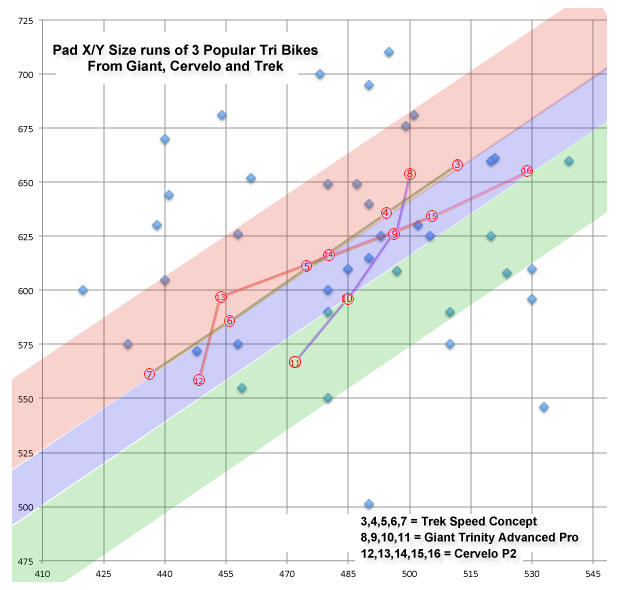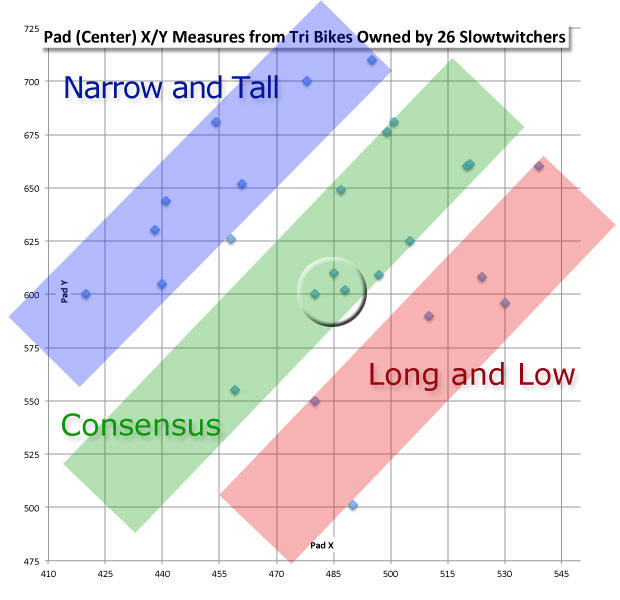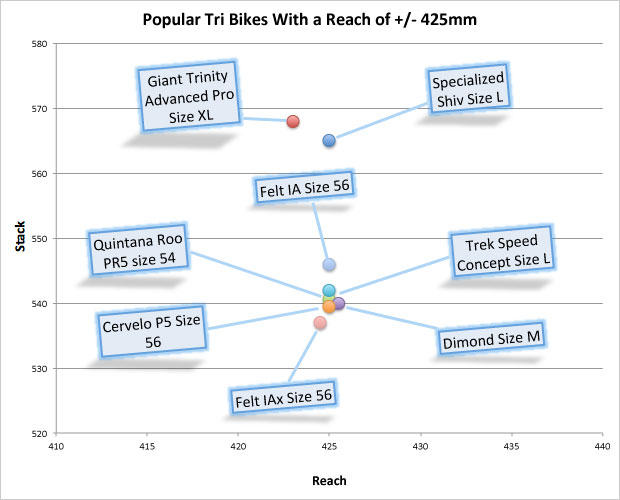Tri Bikes are Too Tall
The horizontal and vertical distance from the bottom bracket (where the crank attached to the frame) to the armrest continues to gain traction in the world of bike fit. In the case of the chart we’re using today, it’s BB to the center of the armrest.
We can “build” a bike from the pads down if we know this metric. How do we know your BB to Pad X and Y distances? You measure it off your existing bike if you like your position; you go to someone you trust to fit you if you aren’t confident in your position and then he or she measures it.
The blue diamonds in the chart are the Pad height (Pad Y) and the Pad length (Pad X), of 3 dozen Slowtwitchers who’ve measured their bikes and reported the numbers. As you might guess, as taller riders have greater pad heights, and these taller riders' pads are also pushed further in front of the bottom bracket. Therefore, if you plotted the Pad X and Y of 5 riders, each 2 inches taller than the next, and you plotted the intersections of their Pad X and Y on a Cartesian graph and drew a line through those plotted points you’d get a inclined slope and that’s more or less what we’ve done here.

About a third of all riders participating in this exercise have positions that sit inside that light blue band. This is my own sense of what I’ll call orthodox positions. I think a significant percentage of professional triathletes would find themselves in this band.
The green band represents riders who have positions bike makers ought to accommodate. About a quarter of all the riders on this graph are in this green band. Another quarter of the riders are in the red band, and these riders have perfectly fine positions, pads are higher than the others, and they need accommodation too. Maybe the don’t ride quite as steep as the others. Maybe they have long legs and a short torso, which adds more pad height without as much pad length.
What about those outside the ranges? They need bikes as well. We’ll get to these.
The red circles are size runs using what I consider an optimized front end for each bike. The circles with the numbers 3 thru 7 are the Speed Concept, with 7 being the XL and 3 the XS.
In the case of the Speed Concepts the “optimized" front end I chose is a low/far stem with a 45mm pedestal. This allows the front end to be moved down 30mm, and much as an extra 70mm higher. As far as fore/aft, it’s the middle of the Speed Concept’s range. With this front end, you can see that the size run from XS to XL exactly follows the slope that I chose, and I chose that slope before I performed this exercise. It’s a coincidence that Trek’s slope and mine are the same.
Note, however, that if you drop the pads 30mm, to the Speed Concept’s lowest setting for each size, you barely get into the green. The greenies, who ride a bit longer and lower, can only ride the Speed Concept by going down one frame size, which places more weight over the front wheel.
Circles 12 thru 16 is a Cervelo P2, outfitted with its Profile Design aerobar. This isn’t the entire size run (I was running out of chart!). These are the 5 sizes between 45cm and 56cm. The front end I chose was a stem with a –6° pitch, and only 15mm of headset top cap (or some combo of top cap and spacers). This gives me about 15mm of downward adjustability by changing the stem from a –6° to a –17°, plus an additional 10mm by exchanging this top cap for a 5mm cap. I chose a 70mm stem for the 45cm and 48cm, 80mm for the 51cm, 90mm for the 54cm, 100mm for the 56cm.
The interesting thing about this run is that size run doesn’t follow my slope. Why? Especially because the P2 geometry and Speed Concept geometry are almost identical! It’s because I’m scaling the stem (remember, I didn’t scale the front end of the Speed Concept up and down the size run). If I simply chose an 80mm stem for the entire size run the P2 slope would lay right on top the Speed Concept’s slope. The one outlier is the 45cm P2, which is made with 650c wheels and so has a much lower front end.
Red circles with numbers 8 thru 11 are the Giant Trinity Advanced Pro, in the center of that bike’s range, both in height and length. Note that this bike scales the other direction. It gets taller out of scale as it goes up in size. Why? I don’t know, but I suspect it’s because this frame must perform double duty as a triathlon and TT bike and must therefore consider UCI regulations, which crimps the style of taller riders because of a max length.
The Giant can adjust down 15mm (it’s got a tight height range for each size). As you can see, this means this bike doesn’t dip down into the green range, so long-torsoed riders, or those who just ride low, will have a harder time with this bike.
In fact all these bikes in the configs I chose only have between 15mm and 30mm of downward adjustment in the vertical axis. As you’ll see, this means those riders in the green range or out-of-the-range low are going to have trouble with bikes the way they’re made today, unless they change the handlebars out (which is possible for the P2, harder for the Trek, and impossible for the Giant shown here).
But those in the red band, or even above the red band, have bikes available for them because most aerobars today (Profile, Felt, 3T) have loads of upward adjustment just in pad pedestaling, not to mention stems that point up and headset spacers.
However – and here’s where I pee in the Cheerios – I think a good half of those out of the range high ought to be in the red band and a third of riders in the red band would be in the blue band if they were fit properly and aboard saddles and aerobars optimized for their comfort. In other words, a lot of bike makers today have been making complete bikes that accommodate mediocre or substandard positions.
I didn’t pick 3 outlier companies when I chose the Trek, Giant and Cervelo above. I picked 3 companies making bikes that offer very mainstream geometries that are also used by most other bike brands. Looking at that Speed Concept slope, the Felt IA slope would just about overlay it. Likewise Orbea, Argon18, BMC and others. The Specialized slope courses through the middle of the red band. II just built a Specialized Shiv with a pretty standard Zipp Vuka Alumina aerobar with a Vuka Aero Bull pursuit bar, and I had to put a –25° stem and really fight with the front end just to get into the top edge of the blue band.
Today’s bikes are made to accommodate the middle of the fit spectrum and up. They are not really made to adjust down. This is why the only aftermarket aerobar makers with a ready market are those offering low positions, like the Enve and TriRig aerobars. There is a clear hole in the market, for either aerobar or bike makers who want to exploit it. We’ll see who does.




Start the discussion at slowtwitch.northend.network